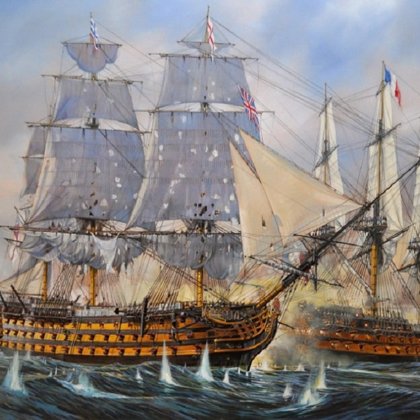THE BATTLE OF TRAFALGAR ON 21ST,OCTOBER ,1805,WAS A NAVAL ENGAGEMENT FOUGHT BY THE BRITISH NAVY AGAINST THE COMBINED FLEET THE FRENCH AND SPANISH NAVY,DURING THE WAR OF COALITION (AUGUST - DECEMBER 1805 OF THE NAPOLEONIC WARS (1803–1815).
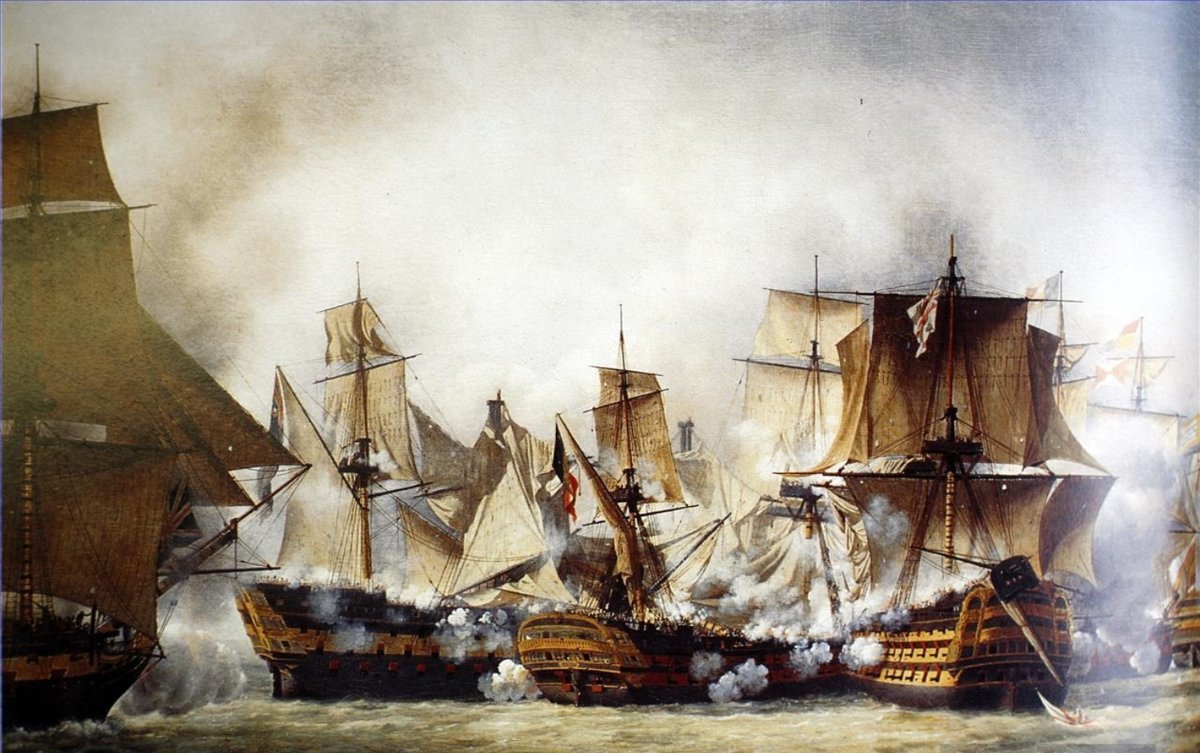 Scene of the battle of Trafalgar,at the Battle of Trafalgar, fought off the southwest coast of Spain on October 21, 1805, a British fleet led by Vice Admiral Horatio Lord Nelson defeated a combined French and Spanish fleet under Vice Admiral Pierre-Charles Villeneuve. It was the most decisive naval battle of the Napoleonic Wars. More than 4,800 people were killed, including Lord Nelson, and over 3,700 were wounded. The majority of the casualties were French and Spaniards. Traveller Robert Semple described the horrible scene at Cádiz, the closest Spanish port, a week after the Battle of Trafalgar.
Scene of the battle of Trafalgar,at the Battle of Trafalgar, fought off the southwest coast of Spain on October 21, 1805, a British fleet led by Vice Admiral Horatio Lord Nelson defeated a combined French and Spanish fleet under Vice Admiral Pierre-Charles Villeneuve. It was the most decisive naval battle of the Napoleonic Wars. More than 4,800 people were killed, including Lord Nelson, and over 3,700 were wounded. The majority of the casualties were French and Spaniards. Traveller Robert Semple described the horrible scene at Cádiz, the closest Spanish port, a week after the Battle of Trafalgar.
The Battle of Trafalgar was fought on the 21st of October 1805 and caused the destruction of the Combined fleet by the Royal Navy. It took place off Cape Trafalgar on the Spanish coast, south of Cape St Vincent, where a previous action took place and south of Cadiz, where the Combined fleet was previously at anchor.All of these required a very high degree of seamanship. Superior standards of British officers, in comparison to the French or Spanish gave the Royal Navy an edge in the battle as the officers were more able to harm the enemy but yet still be on their toes enough to keep their own ships out of most dangers.On October 21, 1805 – Admiral Nelson of the British Royal Navy fought with the combined forces of the French and Spanish Navies off the southern coast of Spain in the Battle of Trafalgar. Although the British were outnumbered and outgunned, Nelson annihilated the Franco-Spanish navies in less than three hours. The victory insured the supremacy of the British Empire and signaled the decline of the Spanish Empire.Admiral Nelson had been playing a game of cat and mouse throughout the Atlantic with Admiral Villenueve of the French and Spanish fleets, and Nelson had grown impatient. Villenueve had led Nelson to the Canary Islands in the hopes of forcing Nelson to leave Great Britain undefended so Napoleon could Great Britain without having to confront the Royal Navy. Consequently, when Nelson received news that Villenueve and his fleet were stationed at Cadiz, Nelson moved to attack. At Cadiz, the French and Spanish forces could easily capture British trading ships as they exited the Mediterranean Sea. The Trafalgar Campaign was a long and complicated series of fleet manoeuvres carried out by the combined French and Spanish fleets; and the opposing moves of the Royal Navy during much of 1805. These were the culmination of French plans to force a passage through the English Channel, and so achieve a successful invasion of the United Kingdom. The plans were extremely complicated and proved to be impractical. Much of the detail was due to the personal intervention of Napoleon, who as a soldier rather than a sailor failed to consider the effects of weather, difficulties in communication, and the Royal Navy. Despite limited successes in achieving some elements of the plan the French commanders were unable to follow the main objective through to execution. The campaign, which took place over thousands of miles of ocean, was marked by several naval engagements, most significantly at the Battle of Trafalgar on 21 October, where the combined fleet was decisively defeated, and from which the campaign takes its name. A final mopping up action at the Battle of Cape Ortegal on 4 November completed the destruction of the combined fleet, and secured the supremacy of the Royal Navy at sea.The exhibition presents some of the most extraordinary and potent objects connected to Nelson, from his boyhood in Norfolk to his death at the Battle of Trafalgar. A British victory, the battle sealed Nelson’s reputation as England’s greatest hero.Although Le Généreux was one of only two ships of the line from the French fleet to escape this historic battle, it was subsequently captured, on 18 February 1800 by Nelson’s flag captain Sir Edward Berry, on board the HMS Foudroyant.When the huge Ensign of Le Généreux was “struck”, that is removed from the flagpole at the rear of the ship, and surrendered to Sir Edward Berry, it was immediately despatched as a gift to the City of Norwich. One of the largest (it measures 16m x 8.3m roughly the size of a tennis-court) and most iconic objects connected to Norfolk’s most famous son, Admiral Lord Nelson, this is the first time this historic object has been on public display for more than a century.The exhibition is built around key objects such as this emblematic ensign, with its remarkable history. In explaining the story of the ensign, together with those of each of the other important exhibits, we are providing insights into Nelson and his times, the cult of his personality and the way he has been lionised and commemorated. Soon after leaving the little creek on which el Puerto de Santa Maria is situate some of the terrible effects of the late battle became visible. On the north-west side, between el Puerto and Rota, lay a large Spanish ship, the San Raphael, seventy-four [guns], broadside upon the rocks, bilged and the waves breaking over her. At the bottom of the bay was a large French ship, aground, but upright. In the centre towards Cadiz lay a group of battered vessels, five or six in number, bored with cannon shot; some with two lower masts standing, others with only one and a piece of a bowsprit, and one without a single stump remaining from stem to stern.As the wind was contrary to our crossing over, the boat was obliged to make several tacks. In one of these we approached so near the shore that we plainly discerned two dead bodies which the sea had thrown up. Presently one of a number of men on horseback, who for this sole purpose patroled the beach, came up, and having observed the bodies, made a signal to others on foot among the bushes. Several of them came down, and immediately began to dig a hole in the sand, into which they dragged the dead. Such is a faint account of the scenes to be observed in the bay of Cadiz eight days after the battle.
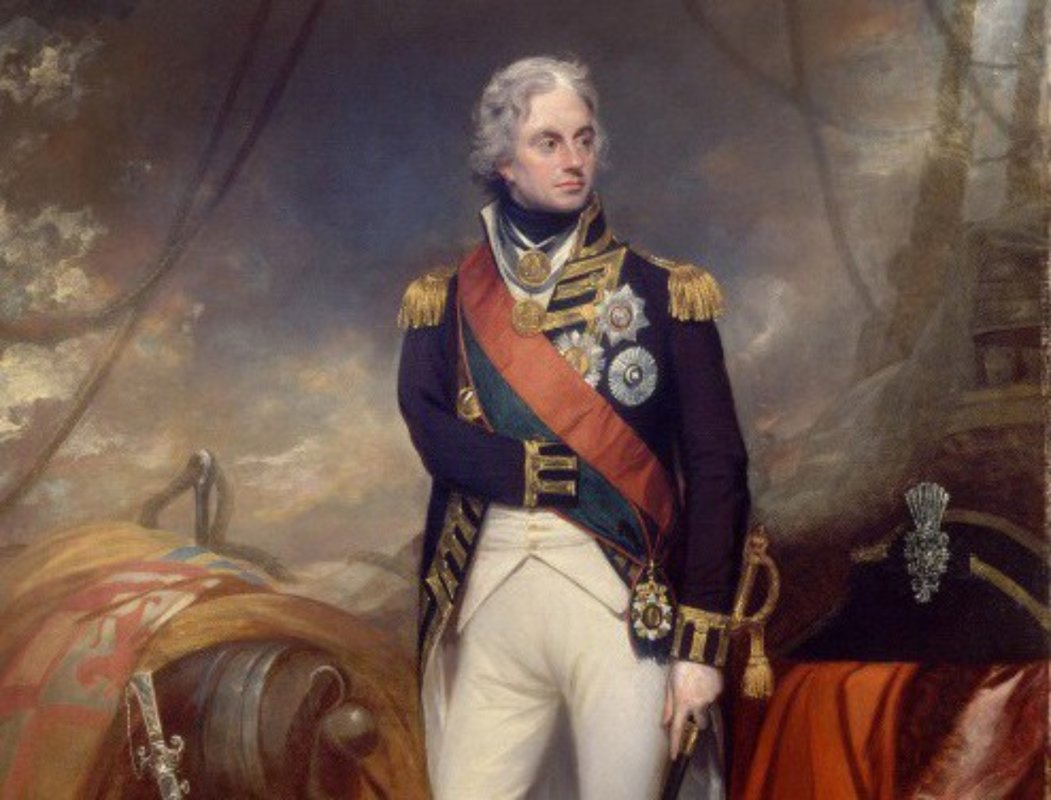 Admiral Lord Nelson was England’s greatest naval heroThe story of how these phrases came to be is a story of a great man, his astounding last moments, the sharp thinking of an Irish surgeon, and the creepy shocking rumors of a crew imbibing the spirits of their venerated leader.Admiral Horatio Nelson was an impressive character, even as a boy. Even though he was a frail child, prone to illness, he swashbuckled in play along the rivers of his hometown, always with an ear for anyone who would tell him seafaring stories.
Admiral Lord Nelson was England’s greatest naval heroThe story of how these phrases came to be is a story of a great man, his astounding last moments, the sharp thinking of an Irish surgeon, and the creepy shocking rumors of a crew imbibing the spirits of their venerated leader.Admiral Horatio Nelson was an impressive character, even as a boy. Even though he was a frail child, prone to illness, he swashbuckled in play along the rivers of his hometown, always with an ear for anyone who would tell him seafaring stories.
Admiral Lord Nelson, Vice Admiral Horatio Nelson, 1st Viscount Nelson, (29 September 1758 – 21 October 1805) was a British flag officer in the Royal Navy. the idol of the British people, was off to fight the French in the Victory, one of the largest ships of her generation.Nelson was barely less famous in his lifetime. Britain was an island nation with an overseas empire; the strength of its navy was central to national pride and economic security. Nelson was not merely a vice-admiral; was not merely the man beating the fearsome Napoleon’s fleet with aplomb and derring-do. Nelson was an officer who led from the front instead of the rear, who promoted men on the basis of merit instead of political connection, who referred to his missing arm as his fin, and flashed it at people who doubted his identity. His ongoing and blatant extramarital affair with a diplomat’s wife was tabloid gold that added an air of scandalous romance to his exploits.The Times ran daily articles about Nelson’s demise and the homeward progress of his ship, the Victory, despite having little to report besides speculation. The eyewitnesses, after all, were still at sea, and electronic communication did not yet exist. Members of the public wrote so many poems of lamentation that the newspaper had to ask them to please stop sending poems , spawning all-Nelson anthologies like 1807’s Luctus Nelsoniani. Although nobody in England yet knew what had transpired in Nelson’s final moments, the Drury Lane Theatre staged nightly re-enactments. There was no escaping Nelson mania.An enormous crowd waited at Portsmouth to do him homage. Almost without exception, they had tears in their eyes as they watched him pass. The reason for the crowd’s emotional reaction to him went beyond the usual sort of hero worship given to national heroes.“He had loved his country with all his heart, with all his soul and with all his strength,” he wrote, “and therefore they loved him as truly and fervently as he had loved England.”The exhibition will be divided into several sections each one examining a key part or element of Nelson’s life and career starting with his birth and early years in his beloved home county of Norfolk. The Norfolk section will include the Burnham Thorpe Parish Register, the village where Nelson was born, which is annotated in the margin by Nelson’s father, rector of the parish, with dates of significant milestones and naval victories. The register will be displayed alongside the poignant “Dear, dear Burnham letter” written by Nelson in 1804. Also of interest is a Freedom Box, presented to Nelson by the Corporation of Thetford following the decision to bestow upon him the Freedom of the town in 1798.Nelson's arrival unsettled Admiral Villeneuve, who was already being bullied by Napoleon, who wanted his fleet to support an attack on Naples. Thus under pressure Villeneuve, believing Nelson's fleet to be weaker than his own, put to sea on 19 October. In fact his 33 ships of the line faced 27 British vessels.The fate of England did indeed lie to a great extent in Nelson’s hands. Napoleon was now master of Europe, and only the sea power of England remained as an obstacle to his ambition. For two years Nelson had been in the centre of the vast military and naval drama, a drama which was to reach its climax in the sea battle in Trafalgar Bay.The revised invasion plan after the death of Latouche Tréville was considerably more ambitious, and consisted of three distinct operations. Latouche Tréville's successor at Toulon, Vice-Admiral Villeneuve, would board 5,600 troops and sail his 10 ships of the line into the Mediterranean on 21 October. Having evaded Nelson he would collect the Aigle from Cádiz and pass through the Strait of Gibraltar, after which he would detach two ships carrying 1,800 troops. He would then head to the West Indies with the rest of his force, while the two detached ships were assigned to fulfil one of the three operations included in the plan. They would sail to Saint Helena and capture the island from the British, before returning northwards to land at Senegal and stir up trouble in West Africa. Meanwhile, Rear-Admiral Missiessy was to sail from Rochefort on 1 November with six ships of the line and 3,500 troops. Having evaded the British blockade he would sail to the West Indies, reinforce the French garrisons at Martinique and Guadeloupe and capture the British colonies of Dominica and St Lucia.Having achieved this Villeneuve and Missiessy would unite and combine forces, giving the French a fleet of 15 ships of the line and 5,000 men. With this force they would capture Surinam and raid other Dutch and British possessions, before sailing back across the Atlantic.While this was taking place Ganteaume and his 21 ships of the line carrying 18,000 troops were to have sailed from Brest on 23 November, passed through the English Channel and into the North Sea, and then sailed around the coast of Scotland. They would arrive at Lough Swilly on the north coast of Ireland and land the troops. While a full-scale invasion of Ireland was under way Ganteaume would sail around the west coast of Ireland, arriving in the Western Approaches in time to meet Villeneuve and Missiessy's forces returning from the West Indies. With a combined force of nearly 40 ships of the line, the French would sweep up the Channel to Boulogne and effect the third and final part of the plan, the invasion of England.This plan, dependant on the weather, the non-interference of the British and subject to the vagaries of communication over thousands of miles of ocean verged on the impossible. The plan was never attempted, as the British intercepted the orders sent to Ganteaume, and the project was called off.
Before the revolution most of the officers were aristocrats, but during the revolution many crews had mutinied, so many Captains had emigrated without even resigning. Junior officers, merchant marine officers, and pilots took their places, and peasants took theirs. The French Navy lost all the discipline it ever had, the “sailors” often were “too frightened” to set the topgallant sails. Their warships ran aground, or collided, due to the incompetence of the officers. However Napoleon wanted a good navy, so he pardoned the officers who had emigrated, officers had to complete training before being commissioned, and more money was given to the Navy, so the French officers were improving quickly, although the French captains were much less competent than their British counterparts, but not due to the revolution.Vice-Admiral Pierre Charles Jean Baptiste Sylvestre de Villeneuve was born in 1763, so was even younger than Nelson, only 42, at Trafalgar although of the same rank. He entered the Navy in 1778; by 1793 he was a capitane de vasseau; this was when he first met Bonaparte.Pierre-Charles-Jean-Baptiste-Silvestre de Villeneuve (31 December 1763 – 22 April 1806) was a French naval officer during the Napoleonic Wars. He was in command of the French and the Spanish fleets that were defeated by Nelson at the Battle of Trafalgar.Villeneuve sailed slowly in the light winds to the south-east. He had in fact guessed what form Nelsons attack would take, but had failed to specify any defence to his captains. The Combined Fleet sailed in a line with the Neptuno in the rear and the San Juan de Nepomuceno commanded by Commodore Churraca in the van. Admiral Gravina was in the Principe de Asturias and Admiral Villeneuve sailed in the Bucentaure. Gravinas' squadron of observation should have been sailing to windward of the Combined fleet , to come to the aid of any part of the line threatened by the British, but had in fact taken up station at the van.In the meantime, Nelson’s ship was moving on, silent and intent, searching for the French admiral’s ship, a task which was something in the nature of a lottery, as the enemy flew no colours. Eventually, right in front of her, lay the huge four-decker, Santissima Trinidad. Correctly divining that the French admiral’s ship must be nearby, Nelson bore down on her. As he did so, the Bucentaure, Villeneuve’s ship, and seven or eight other enemy ships, opened fire on her. Still the Victory advanced without firing. By the time she had come close enough to rake the Santissima Trinidad with her larboard guns, 50 of her men had been killed and 30 wounded.It was at this point that the Victory came into collision with the French Redoubtable. With their yard-arms locked, Nelson was now forced to fight at close quarters with a ship whose tops were full of riflemen, a practice Nelson had always forbidden on his own ships, considering it a petty form of warfare that killed men without deciding a battle.Already wrapped in sheets of flame, the two ships drifted slowly through the smoke of battle. Gradually, although the fighting had continued unabated, the smoke cleared a little from the decks of the Victory, enough for the marksmen to see the epaulets of the English officers. A marksman kneeling in the mizzen-top removed a cartridge from his belt that was to do more damage than all the ships of France or Spain.
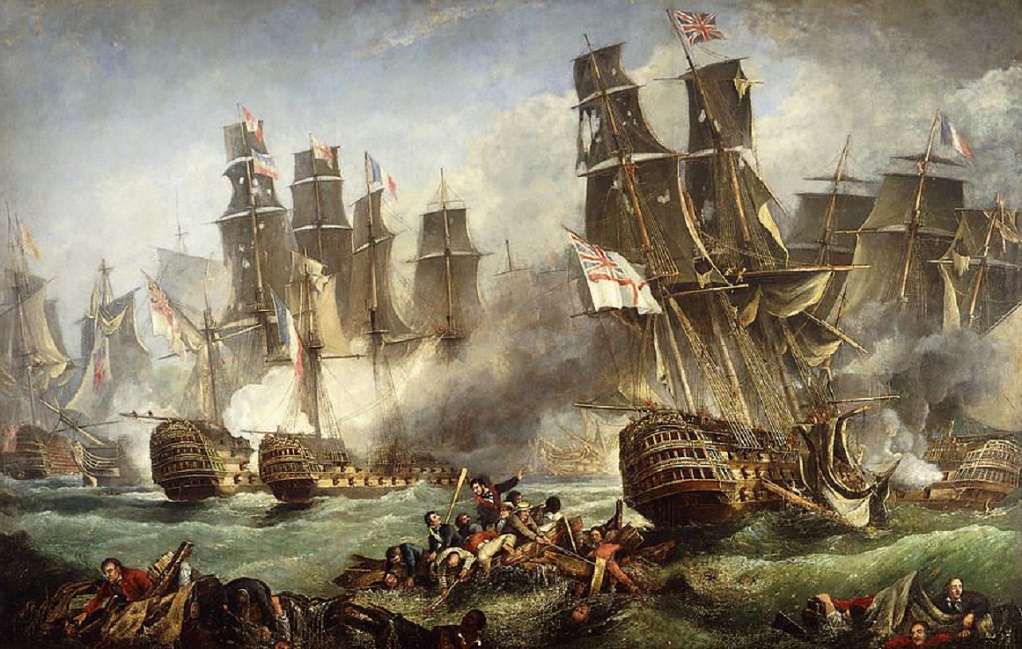 Already wrapped in sheets of flame, the two ships drifted slowly through the smoke of battle. Gradually, although the fighting had continued unabated, the smoke cleared a little from the decks of the Victory, enough for the marksmen to see the epaulets of the English officers. A marksman kneeling in the mizzen-top removed a cartridge from his belt that was to do more damage than all the ships of France or Spain.One column of ships (led by Nelson) would be in the windward position, moving as fast as possible using as much sail power as circumstances allowed. They would split the French and Spanish line in the center, thereby preventing those ships from helping the rest of their fleet.
Already wrapped in sheets of flame, the two ships drifted slowly through the smoke of battle. Gradually, although the fighting had continued unabated, the smoke cleared a little from the decks of the Victory, enough for the marksmen to see the epaulets of the English officers. A marksman kneeling in the mizzen-top removed a cartridge from his belt that was to do more damage than all the ships of France or Spain.One column of ships (led by Nelson) would be in the windward position, moving as fast as possible using as much sail power as circumstances allowed. They would split the French and Spanish line in the center, thereby preventing those ships from helping the rest of their fleet.
The Fall of Nelson, Nelson is portrayed at the moment he falls on his left side. Captain Hardy, with his back to the viewer, advances to assist Royal Marine Sergeant Secker, who is already at Nelson's side. In the centre foreground, Midshipman Pollard aims with a musket, to return the fire of the French marksman who shot Nelson, and a marine to his left also prepares to fire. In the midst of the action. In the immediate foreground, a sailor who has been shot falls backwards on to the deck. In the left foreground, a gun is being sponged and primed by its crew, while beyond it another is being fired. A group of marines fire over the port gunwale towards the Franco-Spanish 'Santissima Trinidad', 140 guns, while a corporal and marine carry off one of the officers, possibly Captain Adair of the marines, who was killed. In the left background, gun-crews operate the port fo'c'sle guns. In the left centre of the picture, beyond the gunner in the foreground, a powder monkey has been hit and clutches his left hip, in a gesture imitating that of Nelson. Behind him lies a dead sailor. Two sailors work on the halliards at the bottom of the mainmast. In the barge are three marines, one dead, one firing into the 'Redoutable', 74 guns, and one priming his musket. Beyond them are figures and smoke on the fo'c's'le. To the right of the mainmast, marines fire over the gunwale in the starboard waist towards the 'Redoutable' whose crew are visible through the smoke. The artist has mistakenly shown the high solid gunwales and round bow of the 'Victory', modifications made some years after Trafalgar. Their introduction was influenced by the heavy casualties suffered in the battle.Nelson’s funeral resulted in a public demonstration of grief on a national scale. The dramatic black velvet drape from Nelson’s funeral car, together with the painted silk hatchment, both used at his funeral, have not been seen together since the funeral car was dismantled circa 1826.There is also a uniform worn by a Greenwich Volunteer who guarded Nelson’s coffin during his two-day lying-in-state, a model of the funeral barge made by a French prisoner of war at Norman Cross internment camp, a picture on glass showing Lord Nelson Lying in State by J. Hinton and additional extensive Nelson funeral memorabilia.
Presiding over the exhibition, as a whole, is the large, compelling portrait in oils of Nelson by the artist William Beechey, commissioned by the City of Norwich and completed in 1801. The portrait features another noteworthy exhibit, namely the sword surrendered to Nelson by the Spanish Admiral Xavier Winthuysen after the Battle of Cape St Vincent on 14 February 1797. When two Spanish ships, the San Nicolas and the San Josef, became entangled Nelson was able to board one then the other. On the deck of the San Josef, Nelson received the surrendered swords of the Spanish, including this one. Nelson’s naval officer’s hat, depicted prominently in the portrait and given to the artist William Beechey by Nelson after he sat for the famous portrait, adds further human interest.Nelson & Norfolk is not intended to be a chronology of the life and times of Nelson illustrated by objects. Instead this exhibition takes its starting point and narrative from the objects themselves. In bringing together so much authentic material, the exhibition reflects the ways in which Nelson has been represented in imagery and how his remarkable life story has been told through objects. Likewise a strong cohesive thread is the affection that Nelson had for the county that ‘gave him birth’ and Norfolk’s immeasurable pride in its most famous son. This is the first time that these objects have ever been presented together in one exhibition.As the battle raged, it was suggested that Nelson take the decorations off his coat. The Victory’s captain, Thomas Hardy, knew that sharpshooters would be looking to fire on the Admiral. Nelson’s response was that he had no time to be changing his coat and that he respected the ‘military orders’ of the coat. He also did not want fear of the enemy to overshadow honor.Nelson also refused his removal to two other ships and carried on as the lead ship in the battle. In the fight, men upon his ship were dying horrifying deaths one man was split in two by a cannonball. Through all of this, Captain Hardy and Admiral Nelson remained on deck encouraging and directing their men despite the carnage and danger.Nine hours into it, Captain Hardy turned around to see Nelson down. He had been shot in the spine. As they carried him below, even though he was in great pain and was fully aware of his impending death, the great naval hero stopped the men carrying him so that he could speak to a tiller operator and give him pointers. Working till the last, caring for everyone before himself.
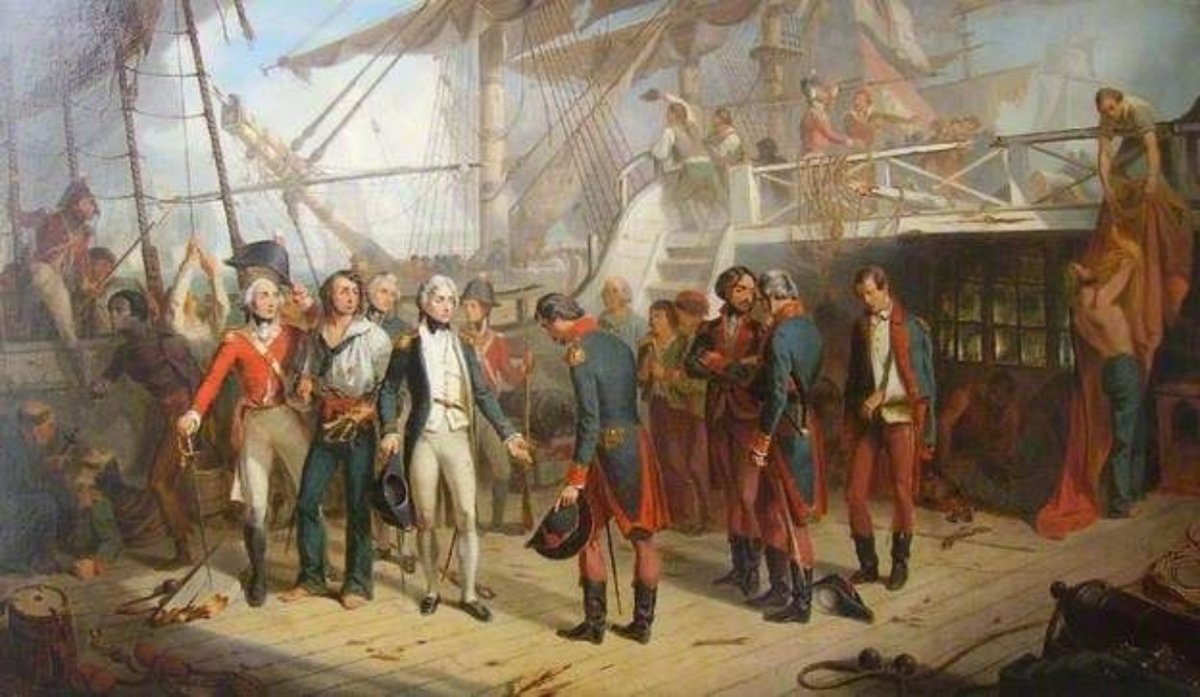
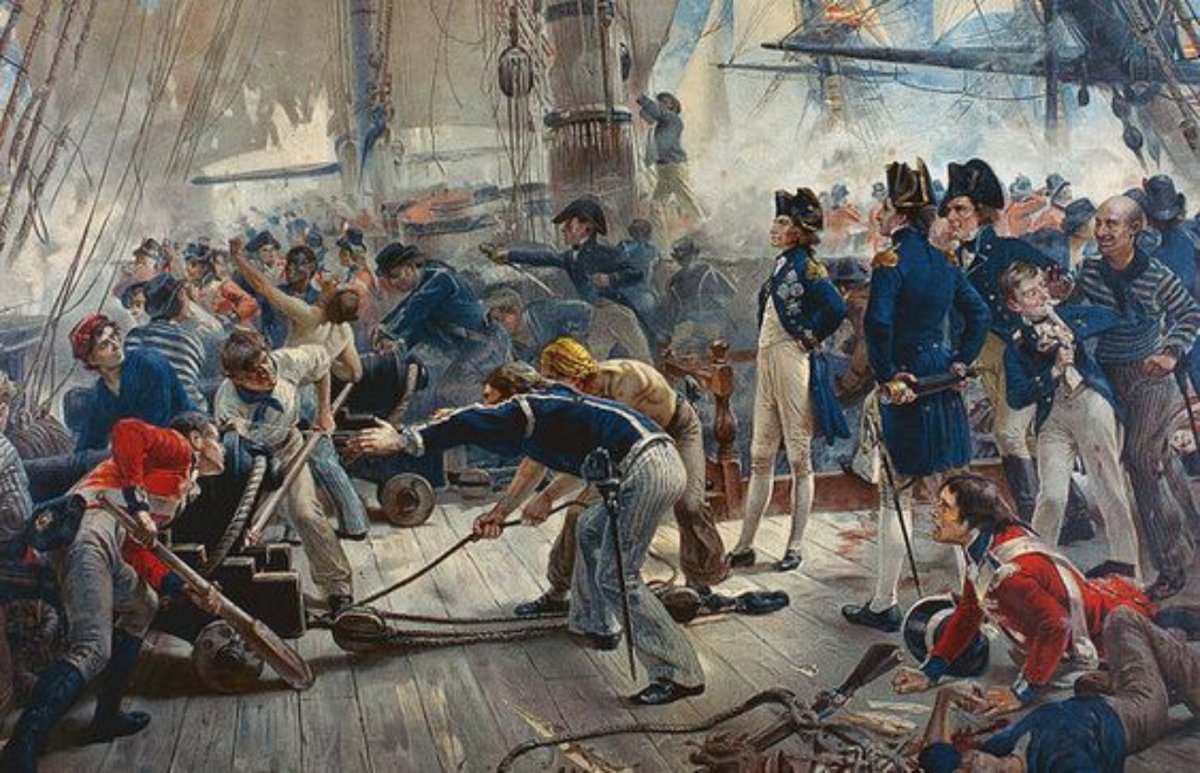
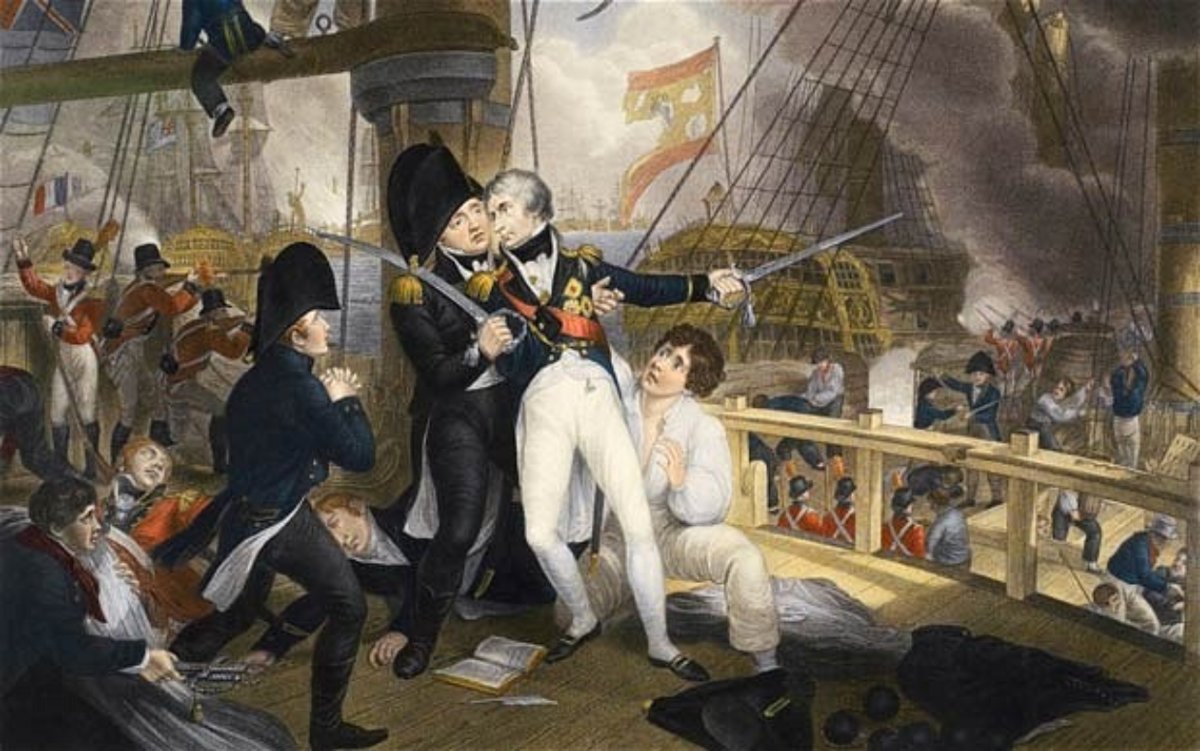 Admiral Nelson is fatally wounded at the Battle of Trafalgar.Nelson met his fate while commanding the HMS Victory through the Battle of Trafalgar. On October 21, 1805, he had 27 ships against Spain’s 33, with no thought of possible defeat. When the enemy began its approach, Nelson, as he often did, decided to use an unusual strategy. Rather than arrange his ships in a straight line, which was the orthodox method, he formed two perpendicular columns. It was a success.He may have known, however, that though he would win the battle he would lose his life.
Admiral Nelson is fatally wounded at the Battle of Trafalgar.Nelson met his fate while commanding the HMS Victory through the Battle of Trafalgar. On October 21, 1805, he had 27 ships against Spain’s 33, with no thought of possible defeat. When the enemy began its approach, Nelson, as he often did, decided to use an unusual strategy. Rather than arrange his ships in a straight line, which was the orthodox method, he formed two perpendicular columns. It was a success.He may have known, however, that though he would win the battle he would lose his life.
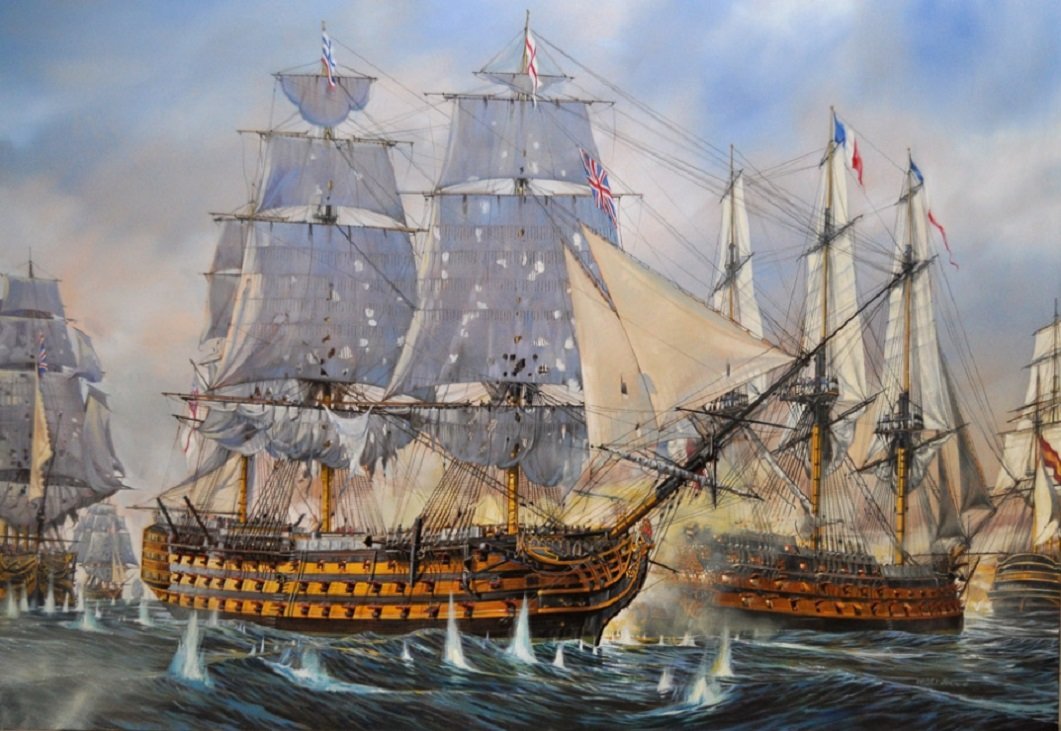 HMS Victory is a 104-gun first-rate ship of the line of the Royal Navy, ordered in 1758, laid down in 1759 and launched in 1765. Its key role was as flagship for the commander in chief, Horatio Nelson, but it also had a secondary role of leading the northerly column into battle. Nelson’s major tactical move was to divide the fleet into two as they advanced toward the Franco-Spanish fleet. It placed itself at the most dangerous position, right at the front of the line. Britain, however, lost the man who had conceived the battle plan. As Victory came into close contact with Redoutable (a French ship), a sniper in her rigging located Nelson who was pacing on the upper deck of his ship.As Nelson lay wounded, the battle with the Redoutable reached a crescendo. The French repeatedly tried to board the Victory, only to be driven back by heavy fire, and at 1.30pm the captain of the Redoutable surrendered.
HMS Victory is a 104-gun first-rate ship of the line of the Royal Navy, ordered in 1758, laid down in 1759 and launched in 1765. Its key role was as flagship for the commander in chief, Horatio Nelson, but it also had a secondary role of leading the northerly column into battle. Nelson’s major tactical move was to divide the fleet into two as they advanced toward the Franco-Spanish fleet. It placed itself at the most dangerous position, right at the front of the line. Britain, however, lost the man who had conceived the battle plan. As Victory came into close contact with Redoutable (a French ship), a sniper in her rigging located Nelson who was pacing on the upper deck of his ship.As Nelson lay wounded, the battle with the Redoutable reached a crescendo. The French repeatedly tried to board the Victory, only to be driven back by heavy fire, and at 1.30pm the captain of the Redoutable surrendered.

